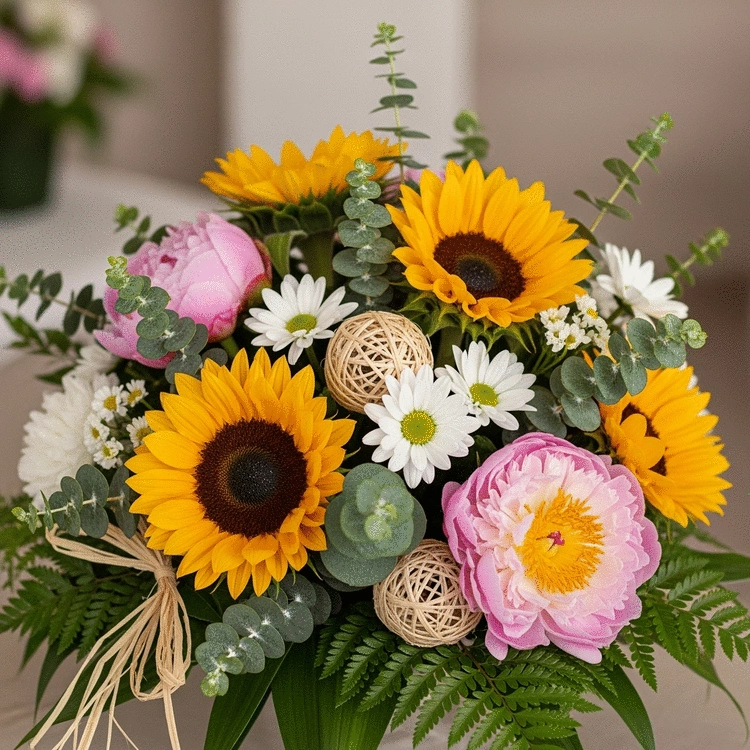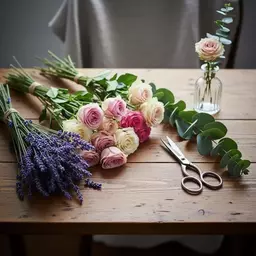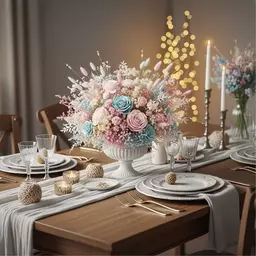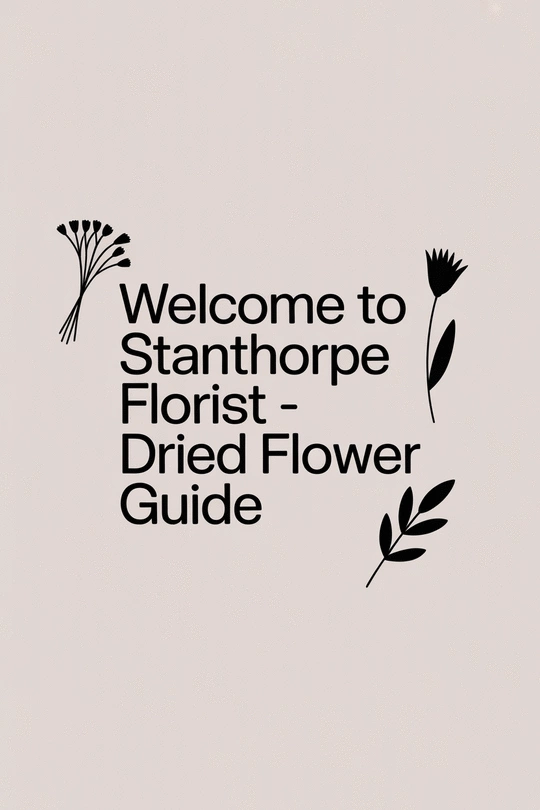The journey toward sustainable floral design goes beyond mere aesthetics; it embodies a profound commitment to our environment. As we explore eco-friendly practices, we can create mesmerizing arrangements that honor nature while promoting sustainability. Are you ready to transform your floral approach and make a positive impact?
What You Will Learn
- Eco-friendly floral design reduces waste and supports local ecosystems, contributing to a healthier planet.
- Choosing dried and preserved flowers extends the lifespan of arrangements, minimizing the need for frequent replacements.
- Utilizing natural materials instead of plastic enhances the sustainability of floral designs.
- Sourcing flowers locally not only supports local economies but also decreases carbon footprints associated with transportation.
- Investing in biodegradable materials, while sometimes more expensive upfront, leads to long-term environmental benefits and reduced waste disposal costs.
- Engaging in composting of leftover flowers is a practical way to recycle waste and enrich the soil.
- Participating in workshops and community engagement fosters awareness of sustainable practices in floral design.
- Community gardens provide a sustainable source of local flowers, encouraging biodiversity and community interaction.
Cost Comparison of Floral Foam Types
Comparing the costs and environmental impact of traditional floral foam versus biodegradable options provides insights into sustainable choices.
Traditional Floral Foam
Average Cost: $10-$20 per block
Environmental Impact: Non-biodegradable, harmful to landfills
Biodegradable Foam
Average Cost: $15-$25 per block
Environmental Impact: Compostable, eco-friendly
Understanding Eco-Friendly Floral Decoration Techniques
As we dive into the world of floral design, it’s vital to understand the beauty of creating arrangements that are not only stunning but also environmentally friendly. At Stanthorpe Florist, we believe that floral decoration can blend artistry with sustainability, allowing us to celebrate nature while protecting it. From choosing the right flowers to the techniques we employ, eco-friendly floral decoration is a rewarding journey that benefits both our homes and the planet.
So, why is sustainable floral design important? Well, traditional floral practices can often lead to waste and environmental harm. By adopting eco-friendly methods, we can reduce our carbon footprint, support local ecosystems, and encourage biodiversity. This conscious approach helps us create not just beautiful spaces but also a healthier planet for future generations. Embracing these practices might feel overwhelming at first, but together, we can make a meaningful impact!
The Importance of Sustainable Floral Design
In our quest to beautify our spaces, we must remember that our choices have consequences. Sustainable floral design emphasizes the use of practices that minimize harm to the environment. By prioritizing eco-friendly techniques, we not only contribute to a cleaner world but also inspire others to follow suit. Below are key reasons why sustainable floral design matters:
- Reduces Waste: Utilizing materials that are compostable or reusable helps decrease landfill contributions.
- Supports Local Economies: Sourcing flowers from local farmers encourages community growth and reduces transportation emissions.
- Promotes Biodiversity: Choosing native flowers can enhance local ecosystems and support pollinator populations.
At Dried Flower Guide, we're dedicated to sharing insights on how to make sustainable choices in floral design. It’s about creating a ripple effect of positive change—each flower arrangement can make a difference! For more information on the impact of various practices, the Environmental Protection Agency provides valuable resources on reducing waste at home, which aligns perfectly with sustainable floral practices.
Key Principles of Eco-Conscious Floral Arranging
Creating eco-friendly floral arrangements doesn’t have to be complicated. By following a few key principles, you can ensure that your designs are both beautiful and sustainable. Here are some fundamental guidelines to keep in mind:
- Choose Dried and Preserved Flowers: These flowers have a longer lifespan, reducing the need for replacements.
- Use Natural Materials: Opt for items like twine, paper, or bamboo instead of plastic to enhance your arrangement.
- Plan for Longevity: Design arrangements that can last, minimizing the need for frequent changes.
By embracing these principles, you can create stunning floral displays that reflect your commitment to sustainability. Every time I arrange flowers at Stanthorpe Florist, I feel the joy of knowing that I'm contributing to a greener future, one bloom at a time!
Pro Tip
Consider creating a floral arrangement that tells a story by incorporating elements from your local environment. Using native flowers and materials not only supports local ecosystems but also adds a personal touch to your design. Each bouquet can reflect the beauty of your surroundings while making a positive impact on the planet!
Cost Comparisons for Eco-Friendly Floral Materials
In an era where sustainability is at the forefront, many of us wonder about the costs associated with eco-friendly floral materials. It’s essential to evaluate both the short-term and long-term benefits of investing in sustainable options. At Stanthorpe Florist, we prioritize not just the beauty of our arrangements but also their impact on the environment. By understanding cost comparisons, we can make more informed choices that reflect our values.
When considering eco-friendly materials, it’s helpful to look at the cost-benefit ratio. Sustainable options may sometimes seem pricier upfront but can lead to significant savings down the road. This can include factors such as reduced waste disposal costs and enhanced durability of certain materials. In addition, many customers are willing to pay a little extra for floral arrangements that align with their values.
- Long-lasting materials decrease the frequency of replacements.
- Organic flowers often have a higher quality, which can enhance the overall arrangement.
- Investing in compostable materials can reduce landfill contributions.
Budget-Friendly Tips for Eco-Friendly Arrangements
Creating stunning floral arrangements while being mindful of your budget is definitely achievable! Here are some practical tips to make eco-friendly choices without breaking the bank:
- Shop at local farmers' markets for fresh, seasonal blooms.
- Opt for DIY projects using recycled materials or what you already have at home.
- Experiment with dried flowers, which can be more cost-effective and last longer.
Using these tips not only helps your wallet but also supports local artisans and promotes sustainability—something we at Dried Flower Guide are passionate about! Don’t hesitate to get creative and think outside the box in your floral designs!
Assessing the Costs of Biodegradable Foam vs. Traditional Foam
When it comes to floral foam, understanding the differences in cost is crucial for making eco-friendly decisions. Traditional floral foam, while convenient, poses a significant environmental issue due to its non-biodegradable nature. On the other hand, biodegradable foam options are becoming increasingly available, but they can have varying price points.
| Foam Type | Average Cost | Environmental Impact |
|---|---|---|
| Traditional Floral Foam | $10-$20 per block | Non-biodegradable, harmful to landfills |
| Biodegradable Foam | $15-$25 per block | Compostable, eco-friendly |
While biodegradable options may be slightly more expensive, the long-term benefits to our planet and your peace of mind can make it a worthwhile investment. As we embrace eco-friendly practices at Stanthorpe Florist, it’s vital to evaluate not just the financial costs but also the environmental costs associated with our floral choices. For additional details on floral foam alternatives and their environmental impact, you can refer to resources like the Slow Flowers Journal, which advocates for sustainable flower sourcing and design.
Common Questions about Eco-Friendly Floral Decorations
As we delve deeper into the world of eco-friendly floral decoration, many questions arise. It’s important to provide clear answers to help guide our readers on their sustainable journey. Here, I’ll address some of the most common inquiries regarding floral sustainability practices, ensuring you feel informed and empowered!
FAQs on Floral Sustainability Practices
Here are some frequently asked questions I often encounter:
- What are the benefits of choosing local flowers? Local flowers are fresher, support local economies, and reduce carbon footprints.
- How can I ensure my floral arrangements are eco-friendly? Consider using biodegradable materials, opting for dried flowers, and sourcing locally.
- What should I do with leftover flowers? Composting is a fantastic way to recycle floral waste and enrich the soil!
- Are dried flowers truly more sustainable than fresh ones? Yes, because they have a much longer lifespan, reducing the need for new purchases and minimizing waste over time.
- How can I find local, sustainable florists in my area? Look for florists who emphasize local sourcing, use biodegradable materials, and participate in community garden initiatives. Websites and local directories focusing on sustainable businesses can also be helpful.
By addressing these questions, I hope to help you feel more confident in making eco-conscious choices that resonate with your values!
Expert Insights from Eco-Conscious Florists
Speaking with other eco-conscious florists has been incredibly enlightening. Their experiences provide valuable insights into successful sustainable practices and common challenges they face. Here are some key takeaways:
- Investing in education on sustainable practices can benefit both the florist and the community.
- Collaboration with local artists can lead to unique, sustainably sourced arrangements.
- Customer engagement through workshops can promote awareness and interest in sustainability.
These insights remind us that we’re all part of a broader community committed to making positive changes in the floral industry!
Understanding the Environmental Impact of Floral Choices
It’s essential to understand the impact our floral choices have on the environment. From the cultivation of flowers to their disposal, every step has consequences. Here are a few aspects to consider:
- The carbon footprint of imported flowers is significantly higher than that of local varieties.
- Non-biodegradable materials contribute to pollution and landfill overflow.
- Supporting sustainable practices encourages the industry to shift towards greener methods.
By being aware of these factors, we can make more mindful decisions that promote a healthier planet.
Summary of Practical Eco-Friendly Floral Techniques
As we wrap up our exploration of eco-friendly floral decoration techniques, let’s recap some key takeaways to help you on your sustainable floral journey. Embracing these techniques not only enhances your arrangements but also contributes to a healthier environment.
Recap of Key Takeaways for Sustainable Floral Design
Here are some vital points to remember:
- Choose local and seasonal flowers to minimize environmental impact.
- Utilize biodegradable materials wherever possible.
- Engage in composting to reduce waste.
By following these principles, we can elevate the art of floral design while being stewards of our environment!
Encouraging Community Engagement and Support for Local Florists
It’s heartening to see how communities can come together to support local florists and sustainable practices. Engaging with local businesses not only strengthens your community but also promotes healthier ecosystems!
Inviting Reader Experiences and Testimonials
I’d love to hear your personal experiences with eco-friendly floral design! Have you tried any new techniques or sourced from local florists? Your stories inspire others to embark on their sustainable journeys, so feel free to share your thoughts!
Highlighting the Role of Community Gardens in Sustainable Floristry
Community gardens play a vital role in sustainable floristry by providing a source of local and organic flowers. They foster a sense of community and encourage biodiversity. How wonderful it is to have a place where neighbors can grow and share the beauty of nature! Together, we can cultivate a greener future.
Recap of Key Points
Here is a quick recap of the important points discussed in the article:
- Emphasize the importance of sustainable floral design to reduce waste and support local economies.
- Follow key principles such as choosing dried flowers, using natural materials, and designing for longevity.
- Consider the cost-benefit ratio of eco-friendly materials, which may have a higher upfront cost but lead to long-term savings.
- Engage in budget-friendly practices by shopping local, opting for DIY projects, and using seasonal blooms.
- Understand the environmental impact of floral choices, including the benefits of local flowers and composting.
- Encourage community support for local florists and sustainable practices to foster a healthier ecosystem.






